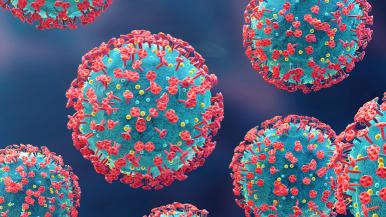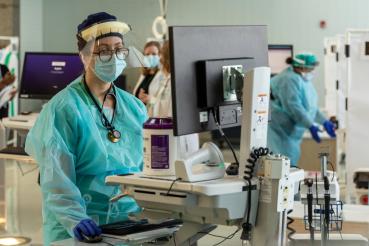While COVID-19 cases and hospitalizations are expected to remain high in Chicago and across the country in the coming weeks, experts at RUSH predict that the worst of the omicron surge may be behind us.
“We’re starting to see signs across the sources that we look at, including international, state and local data, that the current surge is losing some steam,” says Thomas Webb, associate vice president of quality analytics at Rush University Medical Center.
However, Webb says it’s too early to declare that the surge has reached its peak in Chicago. “At RUSH, we are still seeing a very high rate of COVID-19 admissions to the hospital, and we have not seen this start to drop yet. But the good news is that it has stopped growing even higher,” he says.
RUSH’s analytics help hospitals everywhere
RUSH’s robust and efficient operations as well as strong analytics capabilities have helped staff provide excellent care during the omicron surge.
Webb leads a team of 20 analysts, data scientists, data architects and nurses who review local data on COVID-19 cases and hospitalizations as well as data from New York and the United Kingdom to forecast trends. “We can use them almost like a crystal ball,” he says. Then, they share their predictions with leaders at RUSH to help them prepare for what’s to come.
The analytics team also publicly shares their findings via a web-based COVID calculator that any U.S. hospital can use to understand the COVID-19 situation in their county and forecast their staffing and personal protective equipment (PPE) needs.
Why the surge seems to be slowing
Data suggests that despite causing a greater number of infections compared with previous variants, the highly transmissible omicron variant is causing less severe disease on average, says Michael Lin, MD, MPH, an infectious disease specialist and associate professor at Rush University Medical Center.
Expected hospitalizations and death rates also have been relatively lower during the omicron surge than in previous waves, suggesting that this latest variant causes milder disease compared with prior variants.
“That’s certainly welcome news, perhaps reflecting the biology of omicron as well as some of the immunity that people have built up through vaccinations and prior infections,” Lin says.
Since the pandemic began, researchers have learned that COVID-19 surges tend to follow a pattern. “As we’ve seen from prior waves, each wave seems to peak at about four to six weeks,” he says. “Then, depending on the circumstances, it will fall either quickly or slowly. But it’s unclear why surges lose steam. I suspect that, although many people still may be susceptible to a particular variant, at a local geographic level, the virus itself may lose the ability to find people who are susceptible.”
With so many people being affected by the omicron surge, does that mean we are closer to achieving herd immunity and reaching the end of the pandemic? “The simple answer is ‘yes,’ we’re closer, and we will get there,” Lin says. “The hard answer is, we don’t know when we’ll get there because there are these X factors of unknown variants that may surprise us, as omicron did.”
The challenge of achieving herd immunity
Lin explains why the emergence of new variants after omicron could challenge our ability to achieve herd immunity. “The idea of herd immunity assumes that there’s good ‘cross immunity’ with new variants, but that has not been the case with omicron,” Lin says. That explains why some people infected by previous variants like delta have been getting reinfected with omicron.
Still, Lin believes that COVID-19 will eventually become a more predictable disease much like the flu. “We expect that, although COVID-19 will not go away completely, it likely will have more of a predictable pattern where we’ll see more cases during the traditional cold and flu season and much less in the off season,” Lin says. “So, if it does strike that pattern and if illness can be managed from a health care perspective, then we’ll be at the point where we can say we’ve reached herd immunity.”
Please do your part to stop the surge. Schedule your COVID-19 vaccine or booster today.




